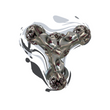The LGBTQ+ community has been on the front lines of fashion for centuries and longer. We've seen drag queens and butch women wearing suits and glitter, queer people pushing boundaries with their clothing choices, and all kinds of queer and trans subcultures come into being for who they are and because of how they dress and express. Here's a brief history of LGBTQ+ style, from the early 20th century to today:
Glitter and Glamour

The glitter and glamour movement was a response to the AIDS crisis in the early 1980s. The conservative politics of this era were focused on condemning homosexuality, while many LGBTQ+ people were dying from an illness that they did not understand. As a result, GLAM (gay, lesbian, bisexual, transgender and queer) people often felt isolated and alone. And so they sought to create a community that celebrated life and love in the face of death.
GLAM fashion became an opportunity for self-expression by creating unique looks with glitter and glamour that were unlike anything else in popular culture at the time.
Black LGBTQ people have a long history of beauty and activism throughout it all
While nowadays it can be exciting times and more opportunities for LGBTQ+ people and the world at large, we must not forget that Black LGBTQ+ people have a long history of the creation of beauty and beauty standards through relentless courage and selfless activism.

Today Black LGBTQ+ icons include singer/songwriter Janelle Monáe who came out publicly as pansexual in 2017; R&B singer Frank Ocean who came out as bisexual around 2012; queer soul singer Kelela Mizanekristos; openly bisexual rapper Angel Haze; openly gay voguer Skylar Kergil (who has been featured on RuPaul’s Drag Race); transgender model Andreja Pejic; gender neutral model Leyna Bloom (also known as “The Androgynous Genderfluid King”)…and so many more, continue to break the barriers of self expression and unique fashion.
There is still a lot of progress to be made.
Even though it may feel like a lot of progress has been made for the LGBTQ+ community, there is still a great deal of work to be done. While there are laws that protect LGBTQ+ people in some countries, others fiercely do not. In fact, over 77 countries around the world criminalize homosexuality or transgenderism. This means that LGBTQ+ people can be arrested and imprisoned simply for who they are, who they love and how they express themselves.
Understanding the LGBTQ+ community through fashion is a way to engage with and learn about a group of people who are more often misunderstood. Fashion has long been a form of creative expression, and it can also be used to create safety, inclusion and happiness. Fashion is one way we communicate our identities and values, so it’s important that we're intentional about what we wear every day.


